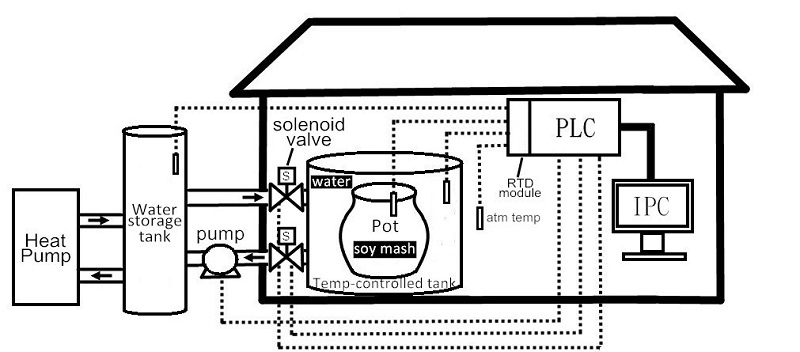Energy-effective Predictive Temperature Control for Soy Mash Fermentation Based on Compartmental Pharmacokinetic Modelling
Keywords:
soy mash fermentation, temperature, predictive control, energy-effective, compartment modelAbstract
Compartment modelling has been successfully used in pharmacokinetics to describe the kinetics of drug distribution in body tissues. In this study, the technique is adopted to describe the dynamics of temperature response and energy exchange in a soy mash fermentation system. The objective is to provide a precise temperature-controlled atmosphere for effective fermentation with the premise of energy saving. In analogy to pharmacokinetics, water and mash tanks are treated as compartments, energy flow as drug delivery, and the temperature as the drug concentration in a specific compartment. The model allows us to estimate the time of injecting a certain amount of energy to a specific tank (compartment) in a cost-effective way. Thus, model-based temperature control and energy management can be possible.
References
N. W. Su, M. L. Wang, K. F. Kwok, and M. H. Lee, “Effects of temperature and sodium chloride concentration on the activities of proteases and amylases in soy sauce koji,” Journal of Agricultural and Food Chemistry, vol. 53, no. 5, pp. 1521-1525, March 2005.
Y. Zhu and J. Tramper, “Koji: Where east meets west in fermentation,” Biotechnology Advances, vol. 31, no. 8, pp. 1448-1457, December 2013.
J. S. Lee, S. J. Rho, Y. W. Kim, K. W. Lee, and H. G. Lee, “Evaluation of biological activities of the short-term fermented soybean extract,” Food Science and Biotechnology, vol. 22, no. 4, pp. 973-978, August 2013.
C. Cui, M. Zhao, D. Li, H. Zhao, and W. Sun, “Biochemical changes of traditional Chinese-type soy sauce produced in four seasons during processing,” CyTA - Journal of Food, vol. 12, no. 2, pp. 166-175, October 2014.
S. H. Ferng, C. P. Wu, Y. T. Lu, W. H. Huang, T. C. Lin, C. K. Hsu, J. S. Ju, and C. H. Ting, “Automatic control of soy mash fermentation for performance promotion using green energy with energy conservation,” The 8th International Symp. Machinery and Mechatronics for Agriculture and Biosystems Engineering (ISMAB), Niigata, Japan, May 2016.
T. R. Chen, and R. Y. Y. Chiou, “Microbial and compositional changes of Inyu (Black soybean sauce) broth during fermentation under various temperature conditions,” Journal of the Chinese Agricultural Chemical Society, vol. 34, no. 2, pp. 157-164, 1995.
X. Gao, C. Cui, H. Zhao, M. Zhao, L. Yang, and J. Ren, “Changes in volatile aroma compounds of traditional Chinese-type soy sauce during moromi fermentation and heat treatment,” Food Science and Biotechnology, vol. 19, no. 4, pp. 889-898, 2010.
N. W. Su, M. L. Wang, K. F. Kwok, and M. H. Lee, “Effects of temperature and sodium chloride concentration on the activities of proteases and amylases in soy sauce koji,” Journal of Agricultural and Food Chemistry, vol. 53, pp. 1521-1525, August 2005.
N. X. Hoang, S. Ferng, C. H. Ting, W. H. Huang, R. Y. Y. Chiou, and C. K. Hsu, “Optimizing the initial moromi fermentation conditions to improve the quality of soy sauce,” LWT - Food Science and Technology, vol. 74, pp. 242-250, December 2016.
T. Olsson, “Evaluating machine learning for predicting next-day hot water production of a heat pump,” 2013 Fourth International Conf. Power Engineering, Energy and Electrical Drives (POWERENG), May 2013.
J. Cummings and C. Withers, “Energy savings and peak demand reduction of a SEER 21 heat pump vs. a SEER 13 heat pump with attic and indoor duct systems,” US Department of Energy, March 2014.
M. Kassai, “A developed method for energy saving prediction of heat-and energy recovery units,” Energy Procedia, vol. 85, pp. 311-319, January 2016.
W. B. Runciman and R. N. Upton, Anaesthetic pharmacology review: pharmacokinetics, Castle House Publications, 1994.
C. M. Faye, D. P. Jerald, D. S. Jeffrey, Heating, ventilating, and air conditioning: analysis and design, 6th ed. John Wiley & Sons, 2004.

Published
How to Cite
Issue
Section
License
Submission of a manuscript implies: that the work described has not been published before that it is not under consideration for publication elsewhere; that if and when the manuscript is accepted for publication. Authors can retain copyright in their articles with no restrictions. is accepted for publication. Authors can retain copyright of their article with no restrictions.
Since Jan. 01, 2019, AITI will publish new articles with Creative Commons Attribution Non-Commercial License, under The Creative Commons Attribution Non-Commercial 4.0 International (CC BY-NC 4.0) License.
The Creative Commons Attribution Non-Commercial (CC-BY-NC) License permits use, distribution and reproduction in any medium, provided the original work is properly cited and is not used for commercial purposes.



